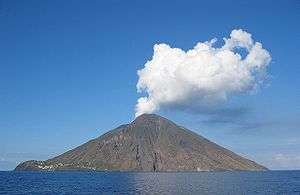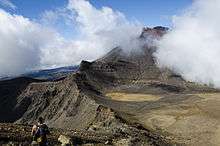Mount Doom
Mount Doom is a fictional volcano in J.R.R. Tolkien's Middle-earth legendarium. It is located in the northwest of the Black Land of Mordor and close to Barad-dûr. Alternative names, in Tolkien's invented language of Sindarin, include Orodruin ("fiery mountain") and Amon Amarth ("mountain of fate").
| Mount Doom | |
|---|---|
| J.R.R. Tolkien's legendarium location | |
.jpg) Mount Doom as depicted in the Lord of the Rings film trilogy. | |
| Information | |
| Type | Volcano |
| Ruler | Sauron |
| Notable locations | the Chambers of Fire, the Cracks of Doom |
| Other name(s) | Orodruin, Amon Amarth, the Fiery Mountain |
| Location | Mordor |
The Sammath Naur ("Chambers of Fire"), located high up in the mountain's cone, were made by the Dark Lord Sauron in the Second Age. They comprised a tunnel leading to an interior platform with molten lava below it, known as the Cracks of Doom. It was here Sauron forged the One Ring during the Second Age.
The mountain represents the endpoint of Frodo Baggins' quest to destroy the Ring, which is recounted in The Lord of the Rings. The mountain's chambers are the site where the One Ring was originally forged by Sauron, and the only place it can be destroyed.
Fictional history
When Sauron began searching Middle-earth during the Second Age for a permanent dwelling place, his attention was immediately drawn to Mordor, and especially to Orodruin, whose power he believed he could use to his advantage. He subsequently established his kingdom based around Orodruin and "used the fire that welled there from the heart of the earth in his sorceries and his forging". The most famous of Sauron's creations forged at Mount Doom is the One Ring. In The Fellowship of the Ring, Gandalf explains that the materials of which the Ring is made are so durable and the enchantments with which it is imbued so powerful that it can only be destroyed in the Cracks of Doom where it was made.
Orodruin is more than just an ordinary volcano; it responds to Sauron's commands and his presence, lapsing into dormancy when he is away from Mordor and becoming active again when he returns.[1] When Sauron is defeated at the end of the Third Age, the volcano erupts violently.[2]
Concept and creation

According to the fanzine Niekas, Tolkien "caught a glimpse of Mount Doom"[3] when sailing past the volcano of Stromboli off Sicily.[4][3]
Another possible source of the name is a long story by Algernon Blackwood.[5]
Reviewer Bart Higgins noted the similarity between Tolkien's Mount Doom and the volcanic caverns under Venus depicted in Perelandra by Tolkien's friend C.S. Lewis. "In both cases, the book reaches a cataclysmic scene of a struggle in a cavern, ending with an evil being falling into volcanic fire and being consumed. Since it is well known that Tolkien and Lewis frequently shared with each other their respective works in progress, it is reasonable to assume that the resemblance is no coincidence".[6]
Adaptations

In Peter Jackson's film adaptation of The Lord of the Rings, Mount Doom was represented by two active volcanoes in New Zealand: Mount Ngauruhoe and Mount Ruapehu. In long shots, the mountain is either a large model or a CGI effect, or a combination. The production was not permitted to film the summit of Ngauruhoe because the Māori hold it to be sacred, but some scenes on the slopes of Mount Doom were filmed on the slopes of Ruapehu.[7]
Namesakes
The International Astronomical Union names all mountains on Saturn's moon Titan after mountains in Tolkien's work.[8] In 2012, they named a Titanian mountain "Doom Mons" after Mount Doom.[9]
Swedish melodic death metal band Amon Amarth, whose lyrics deal primarily with Viking culture and Norse mythology, are named after the mountain.[10]
References
- "Orodruin". The Encyclopedia of Arda. 28 December 2003.
- Tolkien, J. R. R. (1955), The Return of the King, The Lord of the Rings, Boston: Houghton Mifflin (published 1987), "The Field of Cormallen", ISBN 0-395-08256-0
- Tharoor, Ishaan (25 August 2015). "Where on Earth is the real-world Mordor?". Washington Post.
- Kilby, Clyde S.; Plotz, Dick (1968). "Many Meetings with Tolkien: An Edited Transcript of Remarks at the December 1966 TSA Meeting". Niekas (19): 39–40.
- Nelson, Dale (2004). "Possible Echoes of Blackwood and Dunsany in Tolkien's Fantasy". Tolkien Studies. 1: 177–181. doi:10.1353/tks.2004.0013.
- Bart Higgins, "Common Themes and Issues", in Barbara Brown-Smith (ed.) "Modern Mythologies".
- Sibley, Brian. The Making of the Movie Trilogy The Lord of the Rings, Houghton Mifflin (2002).
- International Astronomical Union. "Categories for Naming Features on Planets and Satellites". Gazetteer of Planetary Nomenclature. Accessed Nov 14, 2012.
- International Astronomical Union. "Doom Mons". Gazetteer of Planetary Nomenclature. Accessed Nov 14, 2012.
- "Amon Amarth". Discogs. Retrieved 28 March 2020.
Further reading
- Ian Brodie (2003). The Lord of the Rings Location Guidebook. Harper Collins. ISBN 1-86950-491-7.
- Larsen, Kristine (2007). "Sauron, Mount Doom, and Elvish Moths: The Influence of Tolkien on Modern Science". Tolkien Studies. 4: 223–234. doi:10.1353/tks.2007.0024.
.jpg)